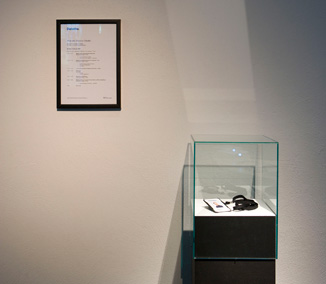
Pilvi Takala, Welcome to Deloitte, Letter and Key Card, The Trainee, 2008
Takala typically trespasses in smaller microcosms, using herself or hired actors and a hidden camera to document a single, subtle act of transgression of established social conduct. In doing so, she unsettles the unspoken rules of these ambiguous societies. Takala, with her unassuming but stubborn demeanour, has just the right tenor of awkward tension and implicit danger. When watching her videos, it’s easy to forget that she is not breaking any specific rules. Like artists such as Sophie Calle, Adrian Piper or Andrea Fraser before her, she tests the boundaries of how threatening or non-threatening a young female artist violating social codes can be.
For Bag Lady (2006), Takala spent several days browsing in a Berlin shopping mall while carrying a clear plastic bag filled with wads of euro notes. While this obvious display of wealth should have made her the ‘perfect customer’, instead she only aroused suspicion from security guards and disdain from shopkeepers. Others urged her to accept a more discreet bag for her money.
Takala also brushed up against the unwritten laws of capitalism in The Trainee (2008), for which she procured a job as a trainee in the marketing department at Deloitte in Helsinki. In her documentation of this month-long performance, Takala sits motionless, like a modern-day Bartleby, at an empty desk. When co-workers attempt to make polite conversation, she replies that she’s ‘doing a bit of brain-work’ or ‘working on my thesis’. But a string of increasingly urgent inter-office emails she obtained shows what they really thought of the new trainee with ‘very short hair’: ‘Obviously she has some sort of mental problem.’ We see how disarmed her colleagues are by her refusal to conform to the rules of the corporate workplace. But we also see how difficult it is for them to break out of their own habits to openly confront her. One video documents an entire day Takala spent going up and down in the office lift. ‘You’re thinking again?’, asks a bemused businessman after his second encounter with the artist. ‘It helps me to see things from a different perspective,’ she explains.
In all these interventions, Takala’s attempt to ‘see things from a different perspective’ emerges as a metaphor for art making, and the suspicion and trepidation with which it’s often regarded in the culture at large. The loneliness that Takala herself likely experiences as an itinerant artist is captured most poignantly inWallflower (2006), which she filmed in a traditional Finnish dancing club. Though the clubs are mostly popular with elderly couples, Takala arrived, unaccompanied, in a rippling floor-length ballroom gown. She sits alone all night until, finally, an old man asks her to dance, and leads her gracefully across the otherwise empty dance floor. Takala’s performance demonstrates how even the most modest or minor infraction can begin to make small, visible cracks in the ice of the social order.